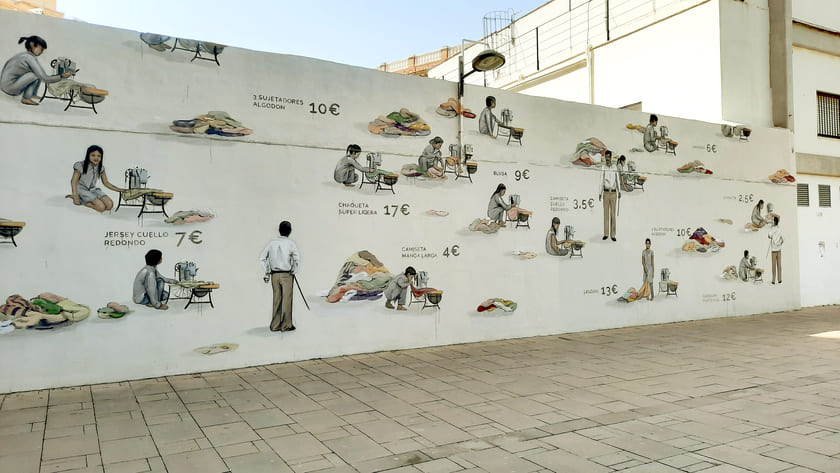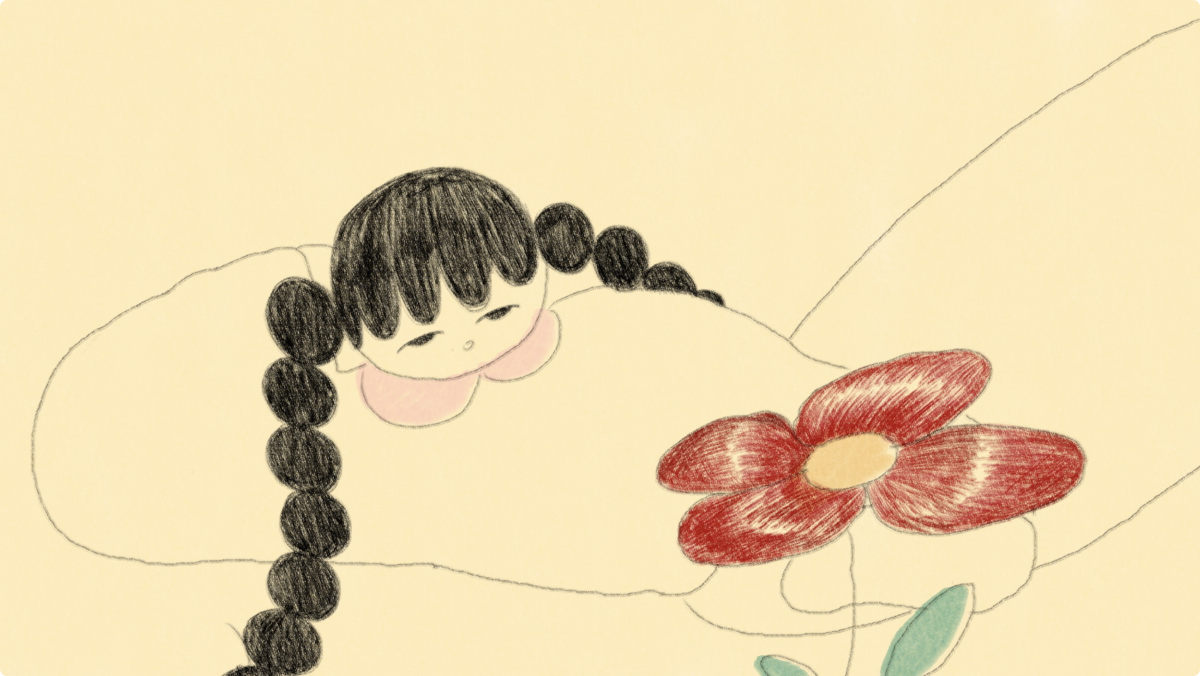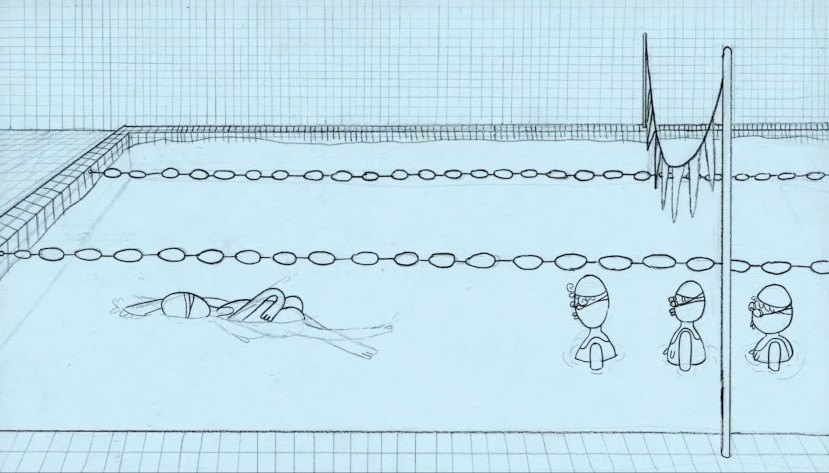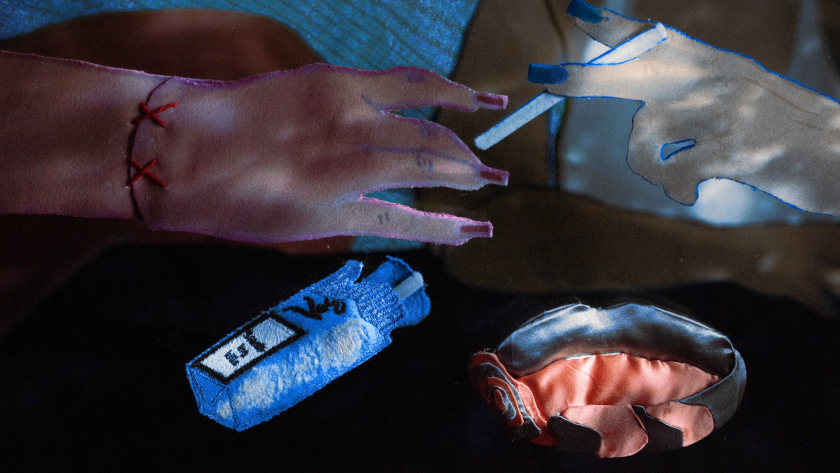Fashion Victims 2.0 by María Lorenzo Hernández

Spanish animator and educator María Lorenzo Hernández is not new in the indie animation circuit. A Goya-nominated animation director (for her 'The Night Ocean'), she continuously alternates between animation creating and animation educating (Chair Professor of Animation at the Faculty of Fine Arts at the Universitat Politècnica de València); between animation inspired by existing forms of art (like her previous 'Urban Sphinx') and 2D animation (the upcoming 'Felina' noir film).
Her latest online release is the short 'Fashion Victims 2.0', based on an existing mural that appeared in València. It participated (among others) in the Annecy Festival 2023, and the Rising of Lusitania Festival -with its more recent presentation at the Stuttgart Festival of Animated Film 2024.
An inconvenient truth: the Western fashion industry stands on forced child labor in the Third World. Will you still consent to it? FASHION VICTIMS 2.0 is the animated recreation of the mural painted by ESCIF in January 2022. The animation short film stresses the nonsense of our unsustainable consumption habits - Film Synopsis
We talked to María Lorenzo Hernández.
ZF: The film's topic looks familiar but at the same time easy to forget (simply because it's familiar). When did the mural painted by ESCIF appear in Valencia, and how did you get the idea of making it into a short animated film?
ML: The mural appeared in January 2022, in a new square in the center of Valencia, Plaza AZA. It is an environment where there are new homes, and branches of several international companies, such as Foster Hollywood and Primark. Precisely, the mural was painted right in front of that clothing store, and that’s why today it still makes a great impact on passers-by since they can simultaneously see both sides of the same coin: buying affordable clothing from a multinational also means collaborating with that kind of unsustainable market.
The history of the mural itself is quite curious, and I did not know until recently: it was painted by ESCIF, a widely recognized Valencian street artist. He is known as “Spanish Banksi” since he emphasizes social criticism. However, the mural was the consequence of a film production: a documentary about a Valencian artistic collective, Equipo Crónica, which also produced ironic works about reality at the time of the Transition (70s / 80s). That is, the mural was commissioned by a film production company and was made with permission from the City Council since the wall on which it is painted belongs to the Bullfighting Museum.
Currently, the permission that the City Council granted for the mural to remain has expired, so the producer must delete it; but there is a lot of controversy and they want to try to preserve it in some way since the ESCIF mural has become a symbol of identity for that city quarter.
ZF: Why do you have the exact title 'Fashion Victims 2.0'?
ML: It is a tribute to the mural itself, which is titled “Fashion Victims”, as it appears written above it. I have intended to transmit the exact message of ESCIF, without any alteration of the image, other than that which involves cutting up the frames and composing a hypothetical movement. ESCIF himself saw the short film and expressed his agreement with the result.

ZF: What was your exact process for animating? I get it that you had to take a lot of mural photographs, and then choose exactly what you wanted to animate.
ML: Indeed, to animate the mural it was necessary to take hundreds of photographs. I took them taking care that the framing, always horizontal, was approximately the same: on the prices, the piles of clothes, the sewing machines, the children, the foremen, various details such as the hands, the feet, the heads, etc.
Then, grouped by theme, the photographs are edited together with Photoshop, taking care of their superimposition. This is the most entertaining part of the process because it is where the magic of movement arises.
Actually, the idea of creating a film from a single painting or a mural, as in this case, is inspired by the work of Gil Alkabetz (1957-2022), who created short films such as 'Travel to China' or 'The Da Vinci Time Code'. In the latest, Gil found rhythms and visual parallels between the characters and elements of Leonardo Da Vinci's painting The Last Supper, just as I have tried to do with the ESCIF mural.
ZF: The image still has the texture of a fabric. I guess this was intentional.
ML: Not at all! It's totally accidental. It is simply the same plaster texture from the wall where the mural was painted. But I like that the viewers participate in the work and can make meaningful associations, thank you!
ZF: Was the sound design work (including the sewing machine sound) something that was thought of later in the process, after animating? Or did everything come along around the same time?
ML: The short film has two ambient sounds: that of a shopping center (very subtle at the beginning and at the end), and in the animated part, the roar of a textile workshop. The idea was to contrast these two worlds. If the short film couldn't show the shopping center, it could at least be heard, to create a greater contrast with the sound of the machines.
Silence is also important. During the editing I understood that “breaking” the sound of the machines over the euro symbol was meaningful; then, a blank image follows, in silence, like an uncomfortable void.

ZF: You are fascinated by street art and the transition from still to the moving image in your previous work as well. How would you describe this tendency? Does it relate only to street art or still images in general?
ML: I am convinced you can animate with all kinds of things. “Animation is the art of movements that are drawn”, as Norman McLaren said. But Street Art also has something special and distinctive: street artists print their icon in any corner of the city, sometimes always the same, other times with variations that are fun to discover. It can be a letter, a signature, a stencil, a portrait, a sticker... It is the same object, but never in the same place or conditions. You often find them half torn off, vandalized, half erased, or damaged by the action of rain and sun, and that gives the images a very special poetics. When you search for street art pieces, you learn to track them and look for the right places to locate their pieces. Normally you won't find them looking in a store window, so they also make you understand that life is more than just consuming and running from one place to another. I feel very grateful for all that Street Art has given me: I love looking for these images, I have not stopped collecting them, and this won’t be my last animated project about Street Art.
ZF: Do you believe that animation is a more effective way than live-action film to use messages of social activism? After all, it has been effectively use in corporate advertising for years.
ML: The graphic image has demonstrated extraordinary effectiveness in transmitting revolutionary messages. Just think about the poster art of the Bauhaus or the propaganda from the Second World War, for example. I love it when images are created to contrast with each other, like an impossible meeting of objects that invite you to reflect. The same thing happens with animation: it is easier to create a metaphorical atmosphere, to create symbols because these resources are produced more naturally than in real-image cinema. Likewise, the graphic image is an abstraction of reality with which it is easier to identify. That's why the message flows more easily.
ZF: Your film does not 'shout out loud' about work exploitation. It lets the images, the characters, and the movements talk about themselves. Is that the way you wanted your film to be? And is this an anti-fashion film?
ML: I believe a message is more effective when it is transmitted with subtlety and irony. This is precisely how ESCIF operates in its murals and illustrations: the idea is forceful, but the form gives room to think about it.
On my behalf, music was one element that it was clear I should not incorporate into the short. Music is by far the most emotional element of any film. If I had included music, the result would have been more melodramatic, and I would even have run the risk of falling on the opposite side of the message since music also tends to embellish everything. That's why this is my only short film that does not include music.
Yet 'Fashion Victims 2.0' is not a short film against fashion itself. Fashion design is also an art. But its main problem comes from the production systems. At the very least, I hope this short film helps many people rethink their consumption habits, and gain awareness about the consequences.
ZF: What is the future of the film after its online release? Could it be part of an installation in the same area the mural now is? Any other ideas you may have?
ML: The intention after the online premiere is, first of all, to share the short as much as possible, just as ESCIF told me they would like. But yes, the idea of making an installation of the screening it at an event organized for this purpose in the same place where the mural is, would be fantastic.
Watch 'Fashion Victims 2.0'
Film Review (Vassilis Kroustallis):
'Fashion Victims 2.0' looks almost like a procedural, business-as-usual film, carefully noticing and focusing (with close-ups, if needed) on three axes: the working children, the people who supervise, and the rising prices. The sitting children, the all-around revolving supervisors, and the immobile money (that keeps the world going round). Genders are eliminated here; being part of the working force is all that matters. The visual texture reinforces the taste of the garment to be worn, while the sound design makes it obvious that this is a repetitive, mundane procedure. 'Fashion Victims 2.0' makes its source mural come alive, but it is still bound to the same constraining conditions that the mural portrays. It is a welcome, lived portrait of exploitation whose short time successfully condenses its reality; relatable and to the point.
Credits:
'Fashion Victims 2.0', experimental animation, 2023 (2'7'', Spain)
Directed by: María Lorenzo Hernández | Production: UPV - Universitat Politècnica de València, María Lorenzo Hernández | Based on: 'Fashion Victims', ESCIF | Animation: María Lorenzo Hernández | Camera: María Lorenzo Hernández | Compositing: María Lorenzo Hernández | Sound: María Lorenzo Hernández | Editing: María Lorenzo Hernández
About María Lorenzo Hernández:
María Lorenzo Hernández (1977) is an animation filmmaker, painter, researcher, and scholar. Her short films have been selected, exhibited, and awarded in more than 40 countries. Nominated for the 2016 Goya Awards for 'The Night Ocean', a film based on a tale by Barlow and Lovecraft, she has explored fantastic narratives and experimental approaches, with a special interest in Street Art. She is Chair Professor of Animation at the Faculty of Fine Arts, Universitat Politècnica de València (Spain).









